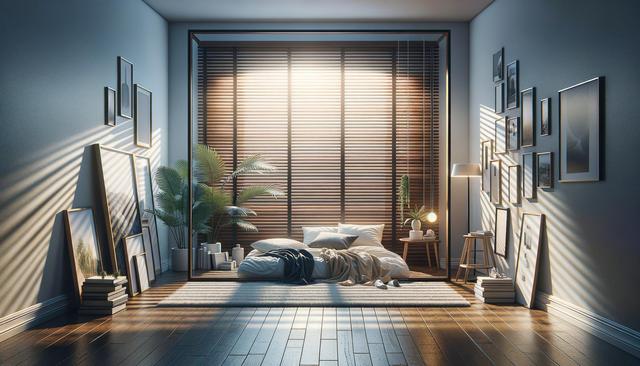Understanding the Different Types of Blinds
Blinds come in a variety of styles, each offering unique advantages depending on your needs and preferences. The most common types include Venetian, vertical, roller, Roman, and panel blinds. Venetian blinds, made of horizontal slats, are widely used due to their flexibility in light control. Vertical blinds, on the other hand, are ideal for large windows and sliding doors, offering a sleek and modern appearance. Roller blinds are a minimalist option, rolling neatly into a tube when raised, while Roman blinds provide a soft, elegant look by folding into pleats. Panel blinds, often used as room dividers or for large patio doors, slide open and closed like drapes.
Each type of blind has its own benefits, and the best choice depends on the room’s purpose, window size, and desired level of privacy. For example, blackout roller blinds are particularly effective in bedrooms where light control is crucial, whereas sheer vertical blinds might be better suited for living rooms to allow natural light while maintaining some level of privacy.
Materials Matter: Choosing the Right Fabric or Finish
The material of your blinds plays a significant role in their durability, maintenance, and aesthetic appeal. Common materials include wood, faux wood, aluminum, vinyl, and various fabrics. Wooden blinds offer a warm, natural look that works well in traditional or rustic interiors. Faux wood, made from composite materials, provides a similar appearance but is more moisture-resistant, making it a better option for kitchens or bathrooms.
Aluminum blinds are lightweight and resistant to corrosion, making them suitable for humid environments. Fabric blinds, available in both light-filtering and blackout options, offer a wide range of colors and textures to match any décor. Some key considerations when selecting materials include:
- Maintenance requirements (e.g., ease of cleaning)
- Moisture resistance for bathrooms or kitchens
- Insulation properties for energy efficiency
- UV protection to prevent fading of interior furnishings
By carefully assessing these factors, you can choose a material that suits your lifestyle and complements your home’s design.
Light Control and Privacy Considerations
One of the primary functions of blinds is to control the amount of light entering a room, as well as to provide privacy. Some blinds offer adjustable slats that allow for precise control over light and visibility, while others must be fully raised or lowered. Venetian and vertical blinds excel in adjustability, allowing you to tilt the slats to achieve the desired lighting without sacrificing privacy.
For spaces that require complete darkness, such as bedrooms or home theaters, blackout blinds are a practical solution. These blinds are usually made from opaque materials that block out nearly all external light. On the other hand, light-filtering blinds are ideal for areas where natural light is welcome but glare needs to be minimized, such as dining rooms or offices.
Here are some tips for balancing light control and privacy:
- Use dual blinds (e.g., a sheer and a blackout layer) for flexibility
- Install top-down bottom-up blinds to adjust visibility and light simultaneously
- Combine blinds with curtains for enhanced insulation and style
Understanding how different blinds function in terms of light and privacy helps you make informed decisions based on the specific requirements of each room.
Measuring and Installation Tips
Proper measurements are essential for blinds that fit well and function smoothly. Whether you choose inside or outside mounts, accuracy is key. For inside mounts, measure the width and height of the window recess in three places (top, middle, and bottom for width; left, center, and right for height). Use the smallest measurement to ensure the blinds fit within the frame. For outside mounts, measure the area you want to cover, adding extra width and height to minimize light gaps and improve privacy.
Installation varies by blind type and mounting style, but most blinds come with a standard set of brackets and instructions. Basic tools usually required include:
- Drill and drill bits
- Measuring tape
- Level
- Screws and wall plugs (if necessary)
Some people prefer professional installation, especially for custom blinds or if drilling into tile or masonry is involved. However, many modern blinds are designed with user-friendly systems that make DIY installation manageable. Double-checking measurements before ordering and during installation can prevent common issues like misalignment or poor fit.
Maintaining and Cleaning Your Blinds
Blinds, like any other part of your home, require routine maintenance to keep them looking clean and functioning properly. The cleaning method depends largely on the material. For instance, aluminum and vinyl blinds can usually be wiped with a damp cloth or cleaned with a vacuum brush attachment. Wooden blinds should be dusted regularly and occasionally cleaned with a wood-safe cleaner to prevent warping or discoloration.
Fabric blinds may require more care. Some are machine washable, while others need to be spot cleaned or professionally cleaned, especially if they are made from delicate materials. To prevent buildup of dust and allergens, consider these regular maintenance tips:
- Dust blinds weekly with a microfiber cloth or duster
- Vacuum fabric blinds with a soft brush attachment
- Use a cleaning solution appropriate for the blind material
- Inspect cords and mechanisms periodically to ensure smooth operation
Maintaining your blinds not only extends their lifespan but also keeps your indoor environment healthier and more pleasant. Well-cared-for blinds can continue to offer functional and aesthetic benefits for many years.
Conclusion: Enhancing Your Home with the Right Blinds
Choosing the right blinds is about more than just aesthetics—it’s about meeting practical needs like light control, privacy, and energy efficiency while complementing your interior style. With so many types, materials, and features available, homeowners have numerous options to customize their window treatments for each room. By considering factors such as material durability, ease of maintenance, and installation preferences, you can select blinds that truly enhance your living space. Whether you’re outfitting a cozy bedroom or a bright kitchen, the right blinds can make a noticeable difference in comfort and functionality.







